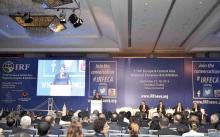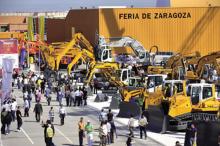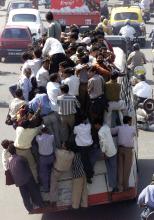The 13th TRAFIC International Road Safety and Equipment Exhibition Fair in Madrid is said to have been a major success. Run recently by IFEMA at FERIA DE MADRID, the event attracted 110 exhibitors and 4,432 trade visitors according to the show organiser. In terms of trade visitor profile, 28% were from the various public administrations, 19% were from engineering and consultancy companies, and 6% from state security bodies. Most of the participating companies consulted agreed that although visitor numbers w
The 13th TRAFIC International Road Safety and Equipment Exhibition Fair in Madrid is said to have been a major success. Run recently by 1157 IFEMA at FERIA DE MADRID, the event attracted 110 exhibitors and 4,432 trade visitors according to the show organiser. In terms of trade visitor profile, 28% were from the various public administrations, 19% were from engineering and consultancy companies, and 6% from state security bodies. Most of the participating companies consulted agreed that although visitor numbers were slightly lower, there were more professionals and decision-makers and a larger international presence.
TRAFIC 2013 was again supported by the Directorate General of Traffic, DGT, and the Directorate General of Roads. It also had the backing of the Basque Regional Government's Directorate of Traffic and Vehicle Fleet, the Catalonian Traffic Service Department, and associations from different sectors represented at the fair.
The parallel FORO TRAFIC innovation sessions included a comprehensive programme of workshops that tackled key issues for the sector. Topics included sustainable road transport, internationalisation, the pivotal role played by highway equipment in road safety and ITS. The workshop on the pivotal role of road equipment in road safety, organised by the2392 Spanish Road Association (AEC), highlighted the improvements achieved in recent years in the various spheres analysed. The latest regulatory developments, CE marking, the importance of standardisation, etc. were among the key themes of the presentations. The programme was also used as an opportunity to present FORO VIAL, a body which seeks to achieve ongoing improvements in road safety in Spain. These planned improvements will focus mainly on boosting the quality and service level of vertical signage, road signs, traffic guidance equipment, lighting, containment systems and anti-noise devices.
The speakers all expressed their concern at the impact of the decline in investment in roads and equipment on traffic safety and on the comfort and service quality provided to the user. The need for more investment in the sector was one of the key conclusions of the gathering.
The VIII Workshops on Urban Traffic Management focused on road safety for the first time, were staged under the title “Road Safety: A Priority for Traffic Engineering. The workshops, which featured 37 speakers over 6 sessions and were attended by 137 professionals, succeeded in uniting the vision of the technicians and the standpoints of both the politicians with responsibility in this area and the victims of violence. It was agreed that there was a need to promote forums with this unified approach.
There was particular interest in the first session, presided over by the Director General of Traffic, which was attended by former Directors of the Directorate-General for Traffic (DGT). In addition to some of the lessons learned during their stints in charge, the speakers emphasised the positive results achieved when road safety is removed from political debate and the key unifying role played by the DGT in leading discussion of this issue at state level, also in the urban arena and even in the regions where interurban traffic management responsibilities have been transferred. They also underscored how this role has become essential again, seeking new solutions to attract resources to the urban sphere and to prevent their further erosion both through budget reduction and the dramatic downsizing being carried out by some companies owing to the economic situation.
The other sessions debated in depth the three main fields of Traffic Engineering but with a focus on safety: planning, road management and regulation. At the meeting of the Traffic Engineers Association the decision was taken to include the Spanish Association in the Latin American Federation of Transport Engineers and Mobility Technicians, based in Peru and chaired by Argentina.
FORO TRAFIC also served as the platform for the presentation of the Madrid Mobility Project, headed by the Madrid Regional Transport Consortium. IFEMA has already started work on TRAFIC 2015, the fourteenth edition of the International Road Safety and Equipment Exhibition, which will take place at FERIA DE MADRID from 29th September to 2nd October 2015.
TRAFIC 2013 was again supported by the Directorate General of Traffic, DGT, and the Directorate General of Roads. It also had the backing of the Basque Regional Government's Directorate of Traffic and Vehicle Fleet, the Catalonian Traffic Service Department, and associations from different sectors represented at the fair.
The parallel FORO TRAFIC innovation sessions included a comprehensive programme of workshops that tackled key issues for the sector. Topics included sustainable road transport, internationalisation, the pivotal role played by highway equipment in road safety and ITS. The workshop on the pivotal role of road equipment in road safety, organised by the
The speakers all expressed their concern at the impact of the decline in investment in roads and equipment on traffic safety and on the comfort and service quality provided to the user. The need for more investment in the sector was one of the key conclusions of the gathering.
The VIII Workshops on Urban Traffic Management focused on road safety for the first time, were staged under the title “Road Safety: A Priority for Traffic Engineering. The workshops, which featured 37 speakers over 6 sessions and were attended by 137 professionals, succeeded in uniting the vision of the technicians and the standpoints of both the politicians with responsibility in this area and the victims of violence. It was agreed that there was a need to promote forums with this unified approach.
There was particular interest in the first session, presided over by the Director General of Traffic, which was attended by former Directors of the Directorate-General for Traffic (DGT). In addition to some of the lessons learned during their stints in charge, the speakers emphasised the positive results achieved when road safety is removed from political debate and the key unifying role played by the DGT in leading discussion of this issue at state level, also in the urban arena and even in the regions where interurban traffic management responsibilities have been transferred. They also underscored how this role has become essential again, seeking new solutions to attract resources to the urban sphere and to prevent their further erosion both through budget reduction and the dramatic downsizing being carried out by some companies owing to the economic situation.
The other sessions debated in depth the three main fields of Traffic Engineering but with a focus on safety: planning, road management and regulation. At the meeting of the Traffic Engineers Association the decision was taken to include the Spanish Association in the Latin American Federation of Transport Engineers and Mobility Technicians, based in Peru and chaired by Argentina.
FORO TRAFIC also served as the platform for the presentation of the Madrid Mobility Project, headed by the Madrid Regional Transport Consortium. IFEMA has already started work on TRAFIC 2015, the fourteenth edition of the International Road Safety and Equipment Exhibition, which will take place at FERIA DE MADRID from 29th September to 2nd October 2015.







